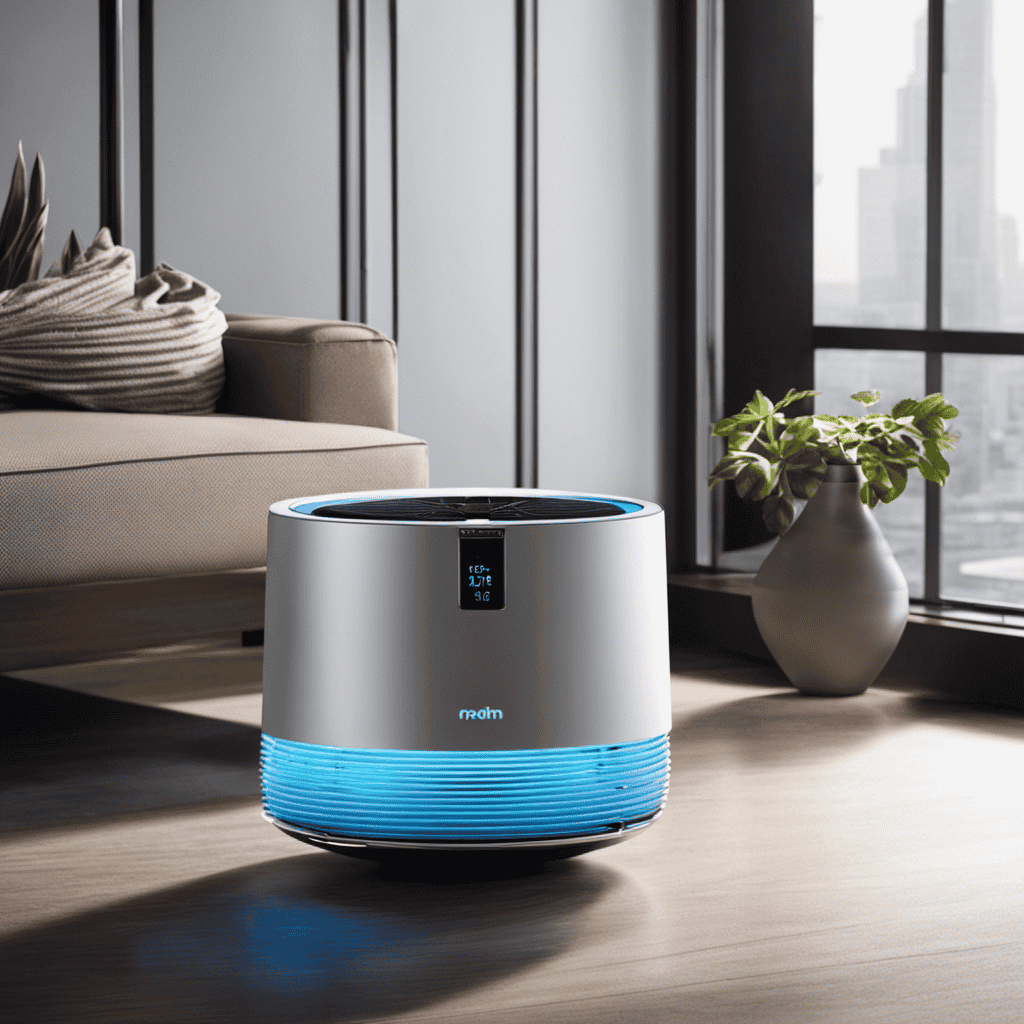As a person who has personally dealt with asthma, I recognize the significance of discovering efficient methods to control the condition.
That’s why I am excited to share with you the benefits of using an air purifier for asthma relief.
In this article, we will explore the causes and triggers of asthma, the role of indoor air quality, and how air purifiers can help.
With the right information and the right air purifier, you can create an asthma-friendly environment that promotes better breathing and a healthier life.
Key Takeaways
- Asthma can be triggered by allergens such as pollen, dust mites, pet dander, or mold.
- Air purifiers can greatly improve indoor air quality by reducing the presence of pollutants that can trigger asthma symptoms.
- Air purifiers can effectively filter out airborne particles such as dust, pollen, pet dander, and mold spores, providing relief and reducing asthma symptoms.
- Creating an asthma-friendly environment includes using air purifiers, identifying and eliminating asthma triggers, implementing effective ventilation systems, and practicing controlled breathing techniques.
Understanding Asthma: Causes and Triggers
If you want to understand your asthma better, it’s important to know the causes and triggers that can worsen your symptoms. Asthma is a chronic respiratory condition characterized by inflammation and narrowing of the airways. The exact cause of asthma is unknown, but it is believed to be a combination of genetic and environmental factors. For some people, asthma can be triggered by allergens such as pollen, dust mites, pet dander, or mold. Other common triggers include respiratory infections, exercise, cold air, and certain medications. Understanding these causes and triggers is crucial for effective management and prevention of asthma attacks.
To manage asthma, it is important to identify and avoid triggers whenever possible. This may involve making changes to your environment, such as using hypoallergenic bedding, keeping your home clean and dust-free, and avoiding exposure to secondhand smoke. Additionally, taking prescribed medications as directed by your healthcare provider is essential for controlling symptoms and preventing asthma attacks. Quick-relief medications, such as bronchodilators, help to open up the airways during an asthma attack, while controller medications, such as inhaled corticosteroids, help to reduce inflammation and prevent symptoms from occurring in the first place.
The Importance of Indoor Air Quality
When it comes to managing asthma, understanding the role of pollutants is crucial.
Pollutants such as dust, smoke, and pet dander can trigger asthma symptoms and exacerbate the condition.
However, using air purifiers can greatly improve indoor air quality, reducing the presence of these pollutants and providing significant health benefits for asthma sufferers.
Asthma and Pollutants
Using an air purifier can help reduce asthma symptoms caused by pollutants. Asthma is a chronic respiratory condition that affects millions of people worldwide. It is characterized by inflammation and narrowing of the airways, leading to symptoms such as wheezing, coughing, and shortness of breath.
Pollutants in the air, such as dust mites, pet dander, pollen, and mold spores, can trigger asthma attacks and worsen symptoms. By removing these pollutants, an air purifier can create a cleaner and healthier indoor environment, reducing the potential triggers for asthma and allergies. With the use of advanced filtration systems, air purifiers can effectively capture and eliminate these harmful particles, providing relief and improving the quality of life for individuals with asthma.
Transitioning into the subsequent section, let’s explore the various health benefits that air purifiers offer beyond managing asthma symptoms.
Health Benefits of Purifiers
To maximize the health benefits of purifiers, you should consider placing them in frequently used areas of your home. Here are three reasons why air purifiers are effective and beneficial:
-
Improved Indoor Air Quality: Air purifiers work by filtering out airborne particles, such as dust, pollen, pet dander, and mold spores. This helps to reduce the presence of allergens and irritants in the air, which can be especially beneficial for individuals with asthma or allergies.
-
Reduction in Respiratory Symptoms: By removing pollutants from the air, air purifiers can help to alleviate symptoms such as coughing, wheezing, and shortness of breath. This can lead to improved respiratory health and a better quality of life for individuals with asthma.
-
Removal of Odors and Volatile Organic Compounds (VOCs): Air purifiers with activated carbon filters can effectively remove unpleasant odors and harmful VOCs from the air. This can be particularly helpful for individuals sensitive to strong smells or those living in areas with high levels of air pollution.
By incorporating an air purifier into your home, you can experience the benefits of cleaner air and potentially reduce asthma symptoms.
Now, let’s explore how air purifiers actually work.
How Air Purifiers Work
If you have asthma, an air purifier can be beneficial by removing allergens and irritants from the air you breathe. Air purifiers work by using advanced technology to filter out harmful particles from the air, helping to improve indoor air quality and reduce asthma symptoms.
One of the key benefits of air purifiers is their ability to remove common allergens such as dust mites, pollen, pet dander, and mold spores. These particles can trigger asthma attacks and cause respiratory distress in individuals with asthma. By capturing and trapping these allergens, air purifiers create a cleaner and healthier environment for asthma sufferers.
Air purifiers also utilize various filtration technologies to target different types of pollutants. The most common types of air purifier filters include HEPA (High Efficiency Particulate Air) filters, activated carbon filters, and ionizers. HEPA filters are highly effective at capturing small particles, while activated carbon filters can remove odors and chemicals from the air. Ionizers work by releasing negatively charged ions that attach to airborne particles, causing them to fall to the ground or stick to surfaces.
Here is a table summarizing the different types of air purifier technologies and their benefits:
| Technology | Benefits |
|---|---|
| HEPA Filters | Removes small particles such as allergens and dust |
| Activated Carbon Filters | Eliminates odors and chemicals in the air |
| Ionizers | Reduces airborne particles and freshens the air |
Choosing the Right Air Purifier for Asthma Relief
When selecting the right air purifier for asthma relief, it’s important to consider the specific needs and preferences of the individual. Not all air purifiers are created equal, and finding the one that suits your needs can make a big difference in managing your asthma symptoms.
Here are three key factors to consider when choosing an air purifier:
-
Air purifier brands: It’s important to choose a reputable brand that is known for producing high-quality air purifiers. Look for brands that have a good track record and positive customer reviews. Some popular air purifier brands known for their effectiveness in reducing asthma triggers include Honeywell, Blueair, and Coway.
-
Filtering technology: Look for air purifiers that use high-efficiency particulate air (HEPA) filters. These filters are designed to capture even the smallest particles, such as dust mites, pollen, pet dander, and mold spores, which can trigger asthma symptoms. HEPA filters are considered the gold standard in air purification and are highly effective in improving indoor air quality.
-
Cost-effective options: While some air purifiers can be quite expensive, there are also cost-effective options available. Look for air purifiers that offer good value for money, with features such as multiple fan speeds, timer settings, and filter replacement indicators. Consider the long-term costs associated with filter replacements and energy consumption to ensure you are getting the most bang for your buck.
Key Features to Look for in an Asthma-friendly Air Purifier
Consider researching and comparing different brands for their filtering technology and cost-effective features to find an air purifier that suits your needs and provides relief for your asthma symptoms. When looking for an asthma-friendly air purifier, there are a few key features to consider.
First and foremost, look for purifiers with asthma-friendly filters. These filters are specifically designed to capture and remove common asthma triggers such as dust mites, pet dander, pollen, and mold spores. HEPA filters are highly recommended as they can remove particles as small as 0.3 microns, ensuring cleaner and healthier air.
Additionally, consider the size of the air purifier. The size of the purifier should be appropriate for the room where it will be placed. A larger purifier may be needed for bigger rooms, while a smaller one may suffice for smaller spaces. By selecting the right size, you can ensure that the air in your room is effectively purified, providing maximum relief for your asthma symptoms.
Now that you know what to look for in an asthma-friendly air purifier, let’s move on to maintenance and cleaning tips to keep your purifier running efficiently and effectively.
Maintenance and Cleaning Tips for Air Purifiers
Now that you know what features to look for, let’s talk about how to maintain and clean your air purifier. Proper maintenance and regular cleaning are essential to ensure that your air purifier is working efficiently and effectively. Here are some maintenance tips and cleaning techniques to help you keep your air purifier in optimal condition:
-
Replace filters regularly: The filters in your air purifier will collect dust, allergens, and other pollutants over time. It is important to check the manufacturer’s recommendations and replace the filters as instructed to maintain optimal performance.
-
Clean the exterior: Dust and dirt can accumulate on the exterior of your air purifier, affecting its appearance and potentially reducing its efficiency. Use a soft cloth or a vacuum with a brush attachment to gently clean the exterior surface.
-
Check and clean the fan: The fan in your air purifier plays a crucial role in circulating the air. Regularly check the fan and clean it if necessary to remove any buildup of dust or debris that could hinder its performance.
Creating an Asthma-Friendly Environment at Home
When it comes to creating an asthma-friendly environment at home, there are three key points to consider: indoor air quality, asthma triggers identification, and effective ventilation systems.
Indoor air quality plays a crucial role in managing asthma symptoms, as poor air quality can exacerbate respiratory issues.
Identifying and eliminating asthma triggers, such as dust mites, pet dander, and mold, is essential in creating a safe and healthy environment.
Additionally, implementing effective ventilation systems can help remove pollutants and improve air circulation, ultimately promoting better respiratory health for individuals with asthma.
Indoor Air Quality
You can improve your indoor air quality by using an air purifier. Here are three ways an air purifier can help in improving air quality and reducing asthma symptoms:
-
Removes airborne allergens: An air purifier can effectively remove common allergens such as dust mites, pollen, and pet dander from the air. By reducing these triggers, it can help alleviate asthma symptoms.
-
Filters out harmful particles: Air purifiers are equipped with filters that capture fine particles like smoke, mold spores, and volatile organic compounds (VOCs). These pollutants can worsen respiratory conditions and trigger asthma attacks. An air purifier can help eliminate them, providing cleaner and healthier air to breathe.
-
Reduces indoor pollutants: Indoor air can be more polluted than outdoor air due to factors like cleaning products, cooking fumes, and off-gassing from furniture or carpets. An air purifier can help reduce these pollutants, creating a safer and healthier environment for asthma sufferers.
Investing in an air purifier can be a valuable addition to your efforts in improving indoor air quality and managing asthma symptoms.
Asthma Triggers Identification
Identifying triggers is crucial in managing asthma symptoms and improving indoor air quality. As someone who has struggled with asthma for years, I understand the importance of pinpointing what triggers my symptoms.
Asthma triggers can vary from person to person, but common triggers include allergens such as dust mites, pollen, pet dander, and mold. By identifying these triggers, I am able to take proactive steps to avoid them and minimize my exposure. This may involve regular cleaning, using air purifiers, and keeping windows closed during high pollen seasons.
Additionally, working with a healthcare professional to create an asthma management plan is vital. This plan may include medication, regular check-ups, and monitoring peak flow readings to ensure optimal control of symptoms.
With proper identification and management of asthma triggers, I am able to lead a healthier and more comfortable life.
Effective Ventilation Systems
Having an effective ventilation system in your home is crucial for maintaining good indoor air quality and reducing the risk of asthma triggers. Here are three key benefits of having a well-designed ventilation system:
-
Removal of pollutants: A proper ventilation system helps to remove pollutants such as dust, pet dander, and volatile organic compounds (VOCs) from the air. These pollutants can worsen asthma symptoms and trigger attacks.
-
Control of humidity levels: High humidity can promote the growth of mold and mildew, which are known asthma triggers. By regulating the humidity levels in your home, a ventilation system can help prevent the growth of these allergens.
-
Fresh air circulation: A ventilation system ensures a continuous flow of fresh air into your living spaces. This helps to dilute indoor pollutants and maintain a healthier environment, reducing the risk of asthma attacks.
While ventilation systems alone may not be sufficient to eliminate all asthma triggers, they work in conjunction with other measures such as air purifiers to provide a comprehensive solution. By investing in both ventilation and air purifier effectiveness, you can significantly improve the air quality in your home and reduce the risk of asthma-related complications.
Other Strategies for Managing Asthma Symptoms
To manage your asthma symptoms, it’s important to consider other strategies in addition to using an air purifier. While an air purifier can help remove allergens and irritants from the air, there are other factors that can trigger asthma attacks. One important aspect to consider is managing stress. Stress can worsen asthma symptoms, so finding ways to relax and reduce stress levels can be beneficial. Additionally, alternative therapies can also be explored as a complementary approach to managing asthma.
Here is a table outlining some alternative therapies that may help in managing asthma symptoms:
| Alternative Therapy | Description |
|---|---|
| Acupuncture | Involves the insertion of thin needles into the skin |
| Yoga | Combines physical postures, breathing exercises, and meditation |
| Herbal remedies | Uses plants and their extracts for medicinal purposes |
| Breathing exercises | Focuses on controlled breathing techniques |
| Homeopathy | Uses highly diluted substances to stimulate healing |
It’s important to note that while these alternative therapies may provide relief for some individuals, they should not replace traditional medical treatments. Always consult with a healthcare professional before trying any new therapies. By considering these strategies, in addition to using an air purifier, you can better manage your asthma symptoms and improve your quality of life.
Frequently Asked Questions
Can Air Purifiers Completely Cure Asthma?
Air purifiers can help improve indoor air quality and reduce asthma triggers, but they cannot completely cure asthma. They are effective in removing airborne particles like dust, pollen, and pet dander, which can worsen asthma symptoms.
However, it is important to note that air purifiers should be used as an adjunct to other asthma treatments, such as medication and allergen avoidance. Consulting with a healthcare professional is crucial to determine the most appropriate treatment plan for managing asthma.
How Long Does It Take for an Air Purifier to Show Asthma Relief?
Air purifiers have numerous benefits and are effective in improving indoor air quality. When it comes to asthma relief, the time it takes for an air purifier to show results can vary depending on factors like the severity of asthma symptoms and the size of the room.
However, with regular use, an air purifier can provide noticeable relief from asthma symptoms within a few weeks. Its ability to filter out allergens and pollutants can significantly improve the overall air quality, reducing asthma triggers and promoting better respiratory health.
Are There Any Side Effects of Using an Air Purifier for Asthma Relief?
Using an air purifier for asthma relief can be effective and helpful. However, it’s important to be aware of potential side effects.
Some individuals may experience dryness or irritation in the throat or eyes due to the air purifier’s filtration process. Additionally, if the air purifier is not properly maintained, it could potentially release harmful particles into the air.
Therefore, it’s crucial to regularly clean and replace filters to ensure the air purifier remains effective and safe for asthma sufferers.
Can Air Purifiers Help With Asthma Attacks Triggered by Exercise?
Air purifiers can be effective in reducing asthma attacks triggered by exercise. They help remove allergens and irritants from the air, such as dust, pollen, and pet dander, which can worsen asthma symptoms.
When choosing an air purifier for asthma relief, it is important to look for one with a HEPA filter, as it can capture tiny particles that can trigger attacks. Additionally, consider the size of the room and the air purifier’s recommended coverage area for optimal effectiveness.
Can Air Purifiers Reduce the Need for Asthma Medications?
Air purifiers have been touted as a potential solution for reducing the need for asthma medications. However, it is important to understand the effectiveness of air purifiers for asthma relief.
While air purifiers can help remove airborne allergens and pollutants, they may not completely eliminate the need for medication. Asthma is a complex condition that requires a comprehensive approach to management.
It is always best to consult with a healthcare professional to determine the most appropriate treatment plan for individual needs.
Conclusion
In conclusion, an air purifier can be a game-changer for those with asthma. It helps to eliminate allergens and pollutants from the air, providing relief and reducing the risk of asthma attacks.
By improving indoor air quality, individuals can create an asthma-friendly environment at home. Regular maintenance and cleaning of the air purifier are essential to ensure its efficiency.
Investing in an asthma-friendly air purifier with key features like HEPA filters and activated carbon can make a significant difference. Remember, with the right tools and strategies, managing asthma symptoms can be easier than ever.










